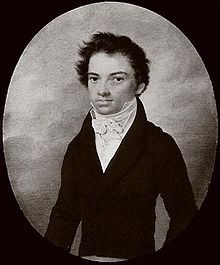Music for a knight ballet
The music for a knight ballet WoO 1 is an early orchestral composition by Ludwig van Beethoven (1770–1827), which was composed in 1790/91 on the occasion of a carnival event by Count Ferdinand von Waldstein .
Origin, premiere and reception
Count Ferdinand von Waldstein was an important patron and sponsor of the young Ludwig van Beethoven. According to a contemporary theater yearbook, on March 6, 1791 ( Shrove Tuesday ), he invited the Bonn nobility to a masked ball in the Bonn Redoutensaal for a "characteristic ballet in old German costume", which reflects the "[...] main inclinations of our forefathers, war, hunting, Love and Zechen […] ”applied. Ludwig van Beethoven contributed the music played, but - probably in consideration of his patron - without naming his name. Thus Waldstein was initially not only considered an organizer and choreographer, but also a composer. Franz Gerhard Wegeler and Ferdinand Ries did not clarify this until 1838 . It is not known whether at least some of the themes in ballet music originated from Waldstein, who also had musical training.
A piano transcription of the music for a knight ballet was published in Leipzig in 1872; the full score was not published until 1888 as part of the complete edition of Beethoven's works published by Breitkopf & Härtel in Leipzig.
Cast, playing time and characterization
The score requires the following scoring: flute piccolo , 2 clarinets , 2 horns , 2 trumpets , timpani and strings .
The playing time of the music for a knight ballet is around 12 minutes. It has the following sentences:
- march
- German singing
- Hunting song
- romance
- War song
- Drinking song
- German dance
- Coda
A repetition of the German chant is inserted after numbers 3 to 6 .
In contrast to the two cantatas composed during Beethoven's time in Bonn ( cantata on the death of Emperor Joseph II , cantata on the elevation of Leopold II to emperor ), the music for a knight's ballet with its miniature movements is kept rather simple and hardly points to the future Work of the composer.
The opening march follows an ABA 'form. The following German chant is rondo-like . The hunting song is opened by horns and clarinets, in the second section strings initially alternate with woodwind and brass before the movement ends in a tutti . The romance is intended for the strings in pizzicato and piano throughout . The war song is shaped by brass and timpani in a way reminiscent of Handel . In Trinklied simple four-bar melodies prevail. In the trio part the piccolo sounds as a soloist. The German dance is held in a 3/8 waltz rhythm. The coda is in two-bar and contains an inserted recapitulation of the German song .
Web links
- Beethoven: Music for a Knight Ballet : Sheet Music and Audio Files in the International Music Score Library Project
- Details Beethoven-Haus Bonn
- Transcripts of parts and other information, Beethoven-Haus Bonn
- Work description by John Palmer at Allmusic (English)
- Information from the Raptus Association for Music Appreciation
Individual evidence
- ^ Extract from a letter from Bonn. In: Heinrich August Ottokar Reichard: Theater calendar to the year 1792 . Carl Wilhelm Ettinger, Gotha 1792, pp. 336–340, here: p. 340 ( digitized in the Google book search).
- ^ Franz Gerhard Wegeler, Ferdinand Ries: Biographical Notes on Ludwig van Beethoven . Bädeker, Koblenz 1838, p. 16 ( digitized in the Google book search).

